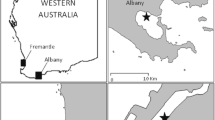Abstract
Since there are not any well developed procedures for site-specifically evaluating the health of fish populations, most field surveillance programs have been restricted to collecting information on chemistry, toxicity, bioaccumulation, biochemical alterations orin situ benthic community structure. Identification of the mechanism and significance of contaminant effects on fish populations depends on the ability to identify changes and to distinguish changes in survival, food availability or food conversion efficiency, from coincidental changes associated with alterations in habitat or natural variability. Preliminary identification of the characteristics of adult fish can be used to cost-effectively focus financial resources on the alterations which are of relevance to interpretation of impacts and identification of causal factors. Proper interpretation requires that appropriate attention be given to monitoring level and strategy, selection of species and timing of sampling, sample size requirements and choice of reference site.
Similar content being viewed by others
References
Baumann, P. C. & J. C., Harshbarger, 1985. Frequencies of liver neoplasia in a feral fish population and associated carcinogens. Mar. Environ. Res. 17: 324–327.
Burke, M. G. & J. F., Leatherland, 1983. Seasonal changes in serum thyroid levels of the feral brown bullhead,Ictalurus nebulosus LeSueur. J. Fish Biol. 23: 585–593.
Cairns, V. W., P. V. Hodson & J. O. Nriagu, 1984. Contaminant Effects on Fisheries. Adv. Environ. Sci. Technol. 16. 333 pp.
Colby, P. J., 1984. Appraising the status of fisheries: rehabilitation techniques. In: V. W. Cairns, P. V. Hodson & J. O. Nriagu (eds), Contaminant Effects on Fisheries. Adv. Environ. Sci. Technol. 16: 233–257.
Edwards, C. J., R. A., Ryder & T. R., Marshall, 1990. Using lake trout as a surrogate of ecosystem health for oligotrophic waters of the Great Lakes. J. Great Lakes Res. 16: 591–608.
Hodson, P. V., 1990. Indicators of ecosystem health at the species level and the example of selenium effects on fish. Environ. Monit. Assessm. 15: 241–254.
McFarlane, G. A. & W. G., Franzin, 1978. Elevated heavy metals: a stress on a population of white sucker,Catostomus commersoni, in Hamell Lake, Saskatchewan. J. Fish. Res. Board Can. 25: 963–970.
Munkittrick, K. R. & D. G. Dixon, 1989a. An holistic approach to ecosystem health assessment using fish population characteristics. In: M. Munawar, G. Dixon, C. I. Mayfield, T. Reynoldson & M. H. Sadar (eds), Environmental Bioassay Techniques & Their Application. Hydrobiologia 188/189: 122–135.
Munkittrick, K. R. & D. G., Dixon, 1989b. Use of white sucker (Catostomus commersoni) populations to assess the health of aquatic ecosystems exposed to low-level contaminant stress. Can. J. Fish. Aquat. Sci. 46: 1455–1462.
Munkittrick, K. R. & J. F., Leatherland, 1984. Abnormal pituitary-gonad function in feral populations of goldfish (Carassius auratus L.) suffering epizootics of an ulcerative disease. J. Fish Diseases 7: 433–447.
Munkittrick, K. R., B. W. Kilgour, W. N. Gibbons & W. M. Gibson, 1990. Baseline studies of the Lesser Slave River. Prep. by E.V.S. Consultants, North Vancouver, B.C., August 1990 for Slave Lake Pulp Corp. under E.V.S. Project No. 3/495-01. Volume 1: 129 pp. + appendices.
Munkittrick, K.R., C. B., Portt, G. J.Van Der, Kraak, I. R., Smith & D. A., Rokosh, 1991a. Impact of bleached kraft mill effluent on population characteristics, liver MFO activity and serum steroid levels of a Lake Superior white sucker (Catostomus commersoni) population. Can. J. Fish. Aquat. Sci. 48: 1371–1380.
Munkittrick, K. R., P. A., Miller, D. R., Barton & D. G., Dixon, 1991b. Impacts of copper and zinc contamination on macroinvertebrate communities and tissue metal distributions in white sucker. Ecotox. Environ. Safety, 21: 318–326.
Niimi, A. J., 1990. Review of biochemical methods and other indicators to assess fish health in aquatic ecosystems containing toxic chemicals. J. Great Lakes Res. 16: 529–541.
Ryder, R. A. & C. J., Edwards, 1985. A conceptual approach for the application of biological indicators of ecosystem quality in the Great Lakes basin. Great Lakes Fish. Comm., Internat. Joint Comm., Windsor, Ontario, 169 pp.
Sherman, R. K., R. E., Clement & C., Tashiro, 1990. The distribution of polychlorinated dibenzo-p-dioxins and dibenzo-p-furans in Jackfish Bay, Lake Superior, in relation to a kraft pulp mill effluent. Chemosphere 20: 1641–1648.
Swanson, S. M., 1982. Levels & effects of radionuclides in aquatic fauna of the Beaverlodge area (Saskatchewan). Sask. Res. Counc. Publ. C-806-5-E-82. 136 pp.
Trippel, E. A. & H. H., Harvey, 1987a. Abundance, growth and food supply of white sucker (Catostomus commersoni) in relation to lake morphometry and pH. Can. J. Zool. 65: 558–564.
Trippel, E. A. & H. H., Harvey, 1987b. Reproductive responses of five white sucker (Catostomus commersoni) populations in relation to lake acidity. Can. J. Fish. Aquat. Sci. 44: 1018–1023.
Author information
Authors and Affiliations
Rights and permissions
About this article
Cite this article
Munkittrick, K.R. A review and evaluation of study design considerations for site-specifically assessing the health of fish populations. J Aquat Ecosyst Stress Recov 1, 283–293 (1992). https://doi.org/10.1007/BF00044170
Issue Date:
DOI: https://doi.org/10.1007/BF00044170




